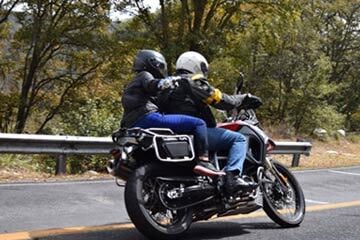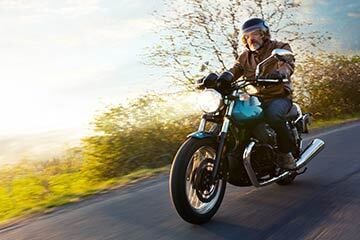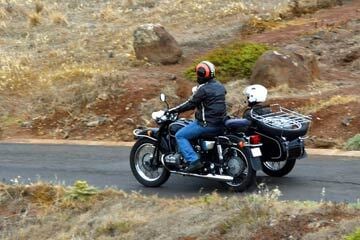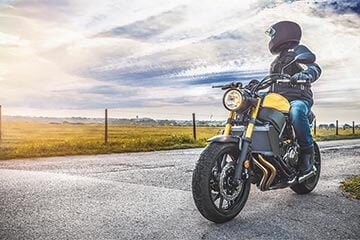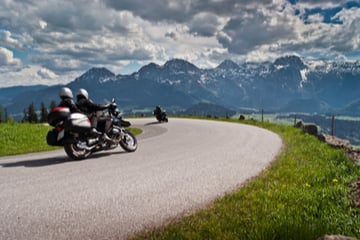What affects the price of motorbike insurance?
There are a range of factors that can affect the price you pay to insure your Kawasaki, including:
- Your age
- Your riding history
- The value of your motorbike
- The engine size of your motorbike
Your age plays a part in determining how much you pay for your motorbike insurance. Older riders usually see a reduction in how much they pay, as insurers see them as more experienced, as well as being less likely to be involved in an accident.
Your riding history has a direct impact on how much you pay for your motorcycle insurance. If you have a clean licence with no convictions or penalty points, you'll pay less for your insurance than someone who has a conviction or who has been banned previously.
The value of your motorbike means the more expensive your motorbike is, the more your insurer will charge for cover, as it'll cost to replace if you're involved in an accident.
The engine size of your motorbike will also affect the cost of your insurance. This is because more powerful bikes are likely to cause more damage in a collision in the eyes of your insurer. As an example, dirt bike insurance on a low-powered scrambler is likely to be different from the insurance you'd get on another Kawasaki model with a more powerful engine. The more powerful your bike is and the more it costs, the more you'll need to pay for insurance.
How can I save money on my motorbike insurance?
There are different things you can do to help you save money your motorbike insurance, including:
Shopping around will make sure you get the best deal and the right level of cover from your policy.
Increasing security by adding extra security devices including chains and locks to your bike when it's parked. Also, parking it in a secure location will help reduce the risk of it being stolen in the eyes of the insurer.
Increasing your voluntary excess means you are increasing the amount you are willing to pay if you have an accident. This means that your insurer will have to pay out less and should be able to offer you a lower premium.
Limit the amount of modifications that you make to your bike, as motorbike modifications can be expensive and will add an additional cost to your policy.
Limiting the optional extras that you add to your policy will reduce the cost. Only pay for the cover that you need for your motorcycle.
Increasing your no-claims bonuswill help save you money on your insurance. Each year you don't make a claim, insurers will normally offer a discount on the cost of your insurance.
Taking an advanced riding course will help show your insurer that you're a safer rider and also lower the chances of you having to make a claim in the future.
Paying annually will avoid you paying small amounts of interest on your insurance premium. This may not be the best option for you, so check the differences between paying annually and monthly before taking out your policy.
History of Kawasaki
Similar to BMW, which originally made aeroplane engines rather than bikes or cars, Kawasaki didn’t start out as a motorbike manufacturer.
Founded in Tokyo by Shozo Kawasaki in 1896, the company was officially known as Kawasaki Heavy Industries. It operated in shipbuilding, railroad rolling stock and electrical generating plants.
Kawasaki retains an interest in a broad range of sectors to this day. But when it came to motorcycles, the big change came in 1960 when Kawasaki took over Meguro Motorcycles.
Kawasaki had been producing motorcycle engines from as early as 1949 and came out with its first bike in 1954, named Meihatsu.
The following year it introduced an improved model, the Meihatsu 125 Deluxe. This time the Kawasaki logo was stamped into the engine side cover.
In 1961, Kawasaki produced its first complete motorcycle post-Meguro takeover – the B8 125cc 2-stroke.
And the new bikes kept coming. 1962 saw a series of the 2-stroke models from 50cc to 250cc released. The 250cc disc-valve ‘Samurai’ attracted particular attention in the US.
Then, 4 years later in 1966, the 650 W1 was launched, the biggest bike made in Japan at the time.
At the end of the 1960s, Kawasaki began making a serious impact on the race track, too. This was when Dave Simmonds won the 1969 World Championship, in the 125cc motorbike class.
In the same year, the Kawasaki H1 (also known as the Mach III) was unveiled. The 500cc 3-cylinder 2-stroke, powerful for its day, helped establish Kawasaki’s reputation in the US.
Because of the bike’s success, Kawasaki released 2 smaller models based on the H1, the 250cc S1 and the 350cc S2.
And for those who wanted more, not less, power, Kawasaki introduced a 748cc version, the H2 (Mach IV) in 1972.
Prestige for the brand provided by victory on the track continued in the early 1980s.
This was when Eddie Lawson won the 1981 AMA Superbike championship for Kawasaki after an epic battle with Honda’s Freddie Spencer.
Innovation and new model design continued at pace during the following decades. In 2003, Kawasaki realised that only a small percentage of super-sports motorcycles ever actually raced.
Consequently, Kawasaki upped the capacity of the ZX-6R to 636cc and ‘ordinary riders’ welcomed a noticeable increase in mid-range power.
Then, 4 years later in 1966, the 650 W1 was launched, the biggest bike made in Japan at the time.
At the end of the 1960s, Kawasaki began making a serious impact on the race track, too. This was when Dave Simmonds won the 1969 World Championship, in the 125cc motorbike class.
In the same year, the Kawasaki H1 (also known as the Mach III) was unveiled. The 500cc 3-cylinder 2-stroke, powerful for its day, helped establish Kawasaki’s reputation in the US.
Because of the bike’s success, Kawasaki released 2 smaller models based on the H1, the 250cc S1 and the 350cc S2.
And for those who wanted more, not less, power, Kawasaki introduced a 748cc version, the H2 (Mach IV) in 1972.
Prestige for the brand provided by victory on the track continued in the early 1980s.
This was when Eddie Lawson won the 1981 AMA Superbike championship for Kawasaki after an epic battle with Honda’s Freddie Spencer. Lawson achieved the same feat a year later too.
Innovation and new model design continued at pace during the following decades. In 2003, Kawasaki realised that only a small percentage of super-sports motorcycles ever actually raced.
Consequently, Kawasaki upped the capacity of the ZX-6R to 636cc and ‘ordinary riders’ welcomed a noticeable increase in mid-range power.

